Does someone have one and give me the length and width.
Thanks.


Griff, I'm curious...I've been using the handpress since I started reloading about 8-9 years ago. The Lee carbide dies I use both decap and size in one step. What advantage is there to using a decap only die (I see that Lee has a universal one for up to .550")? You still need to buy another 3-4 dies for resizing, expanding, bullet seating and crimping (assuming a taper crimp die), so I don't see it saving any money, and it adds a step to the process. Could you enlighten this still novice reloader? For example, are there some of the larger calibers where two steps are needed because of the difficulty of sizing? I have only reloaded for straight-walled and tapered cases, so are rifle case dies different? Thanks for the education.Griff wrote:It's great for some reloading, but for sizin' big BN cases, nuttin' beats a bench mounted press. It's regulated to decappin' & bullet seating chores at my place.
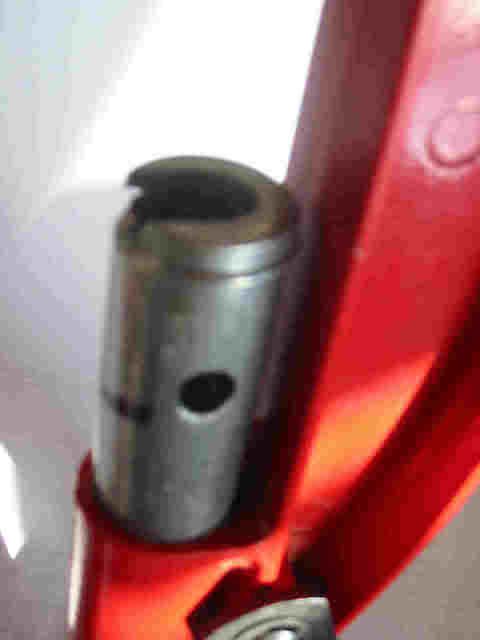
I can fit 40-50 primers in the tube. I just dump it when it fills. With the hole approach, I assume you have to be decapping over a box or something to catch the spent primers? I like the handpress because I can sit in front of the TV watching a game and work on brass in 15-20 minute stages, e.g., decap/size 100-200 cases or bell the mouth, and not having to be in a specific place, like a workroom.AJMD429 wrote:2. The more important modification was to drill a 'primer dump' hole in the side of the ram; the hole under the shell holder is a couple inches deep, but quickly fills with primers, and they have to come out the way they went in - through the little hole in the shell-holder. So I drilled a hole in the side they can fall out of.
Amazing how accurate one can be with the dippers. I find the best technique is not to "scoop", which can compress the powder and cause inconsistency, but to push the back of the dipper "bowl" into the powder and let it fill naturally. I consistently am within 0.1 grains each time. I also picked up a spare set of Lee dippers to handle those "in between" charges. I file down the bowl lip until it drops just what I need for a favorite powder.BlaineG wrote:I just use the powder dippers, too.....with a couple practice runs, I can duplicate the scale weight.
That is the secret...took me a time or two (I can be a little dense sometimes) struggling with dumping the primers with the shell holder in place to have a Duh! moment and just remove it.sore shoulder wrote:Also, I'm not sure I'd want to drill the ram on that, I think when you take the shell holder out the primers pour out pretty easy, making disposing into a can easier
I think he means just take a slice of inner tube (probably 1/2"-1" wide), so you have a thick rubber band, and slip it over the press right where the little protrusion hits the part where the dies screw in.sore shoulder wrote:I'm interested in the inner tube thing but can't quite visualize it AJ.
Yep.alnitak wrote:I think he means just take a slice of inner tube (probably 1/2"-1" wide), so you have a thick rubber band, and slip it over the press right where the little protrusion hits the part where the dies screw in.sore shoulder wrote:I'm interested in the inner tube thing but can't quite visualize it AJ.
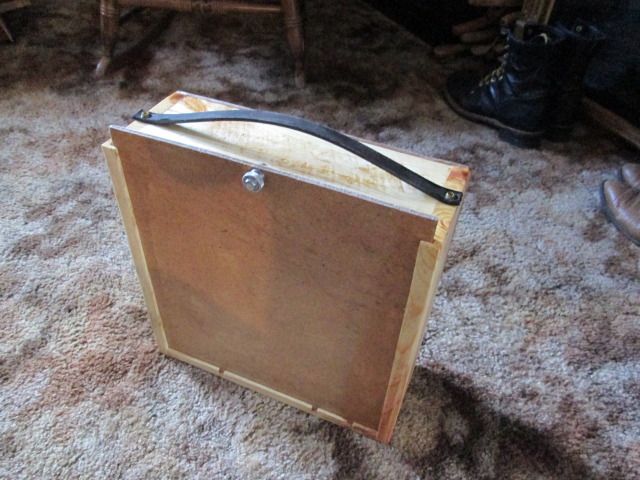
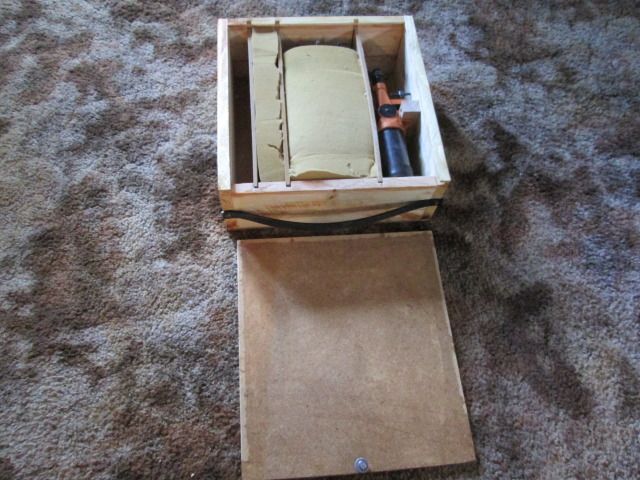
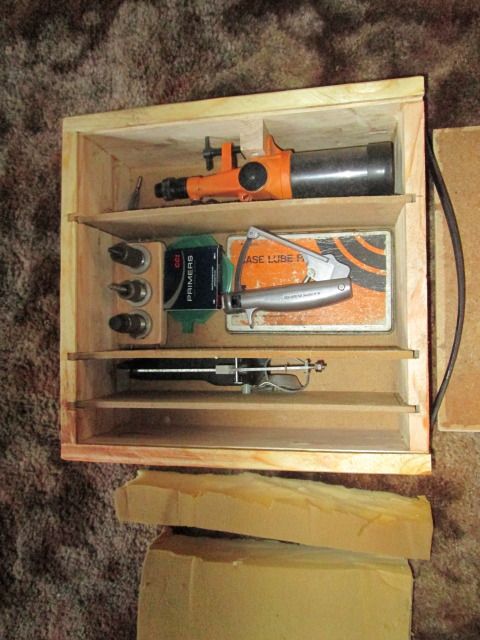
I use the universal to not resize the whole case. I only neck resize to seat the bullet, sometimes not at all. That way, the case is sized to the chamber. I have specific sets of brass per gun. I dont know how much difference it makes, though.alnitak wrote:. What advantage is there to using a decap only die (I see that Lee has a universal one for up to .550")? You still need to buy another 3-4 dies for resizing, expanding, bullet seating and crimping (assuming a taper crimp die), so I don't see it saving any money, and it adds a step to the process. Could you enlighten this still novice reloader? .
Ahhh...now I understand. Thanks!FatJackDurham wrote:I use the universal to not resize the whole case. I only neck resize to seat the bullet, sometimes not at all. That way, the case is sized to the chamber. I have specific sets of brass per gun.
Yeah, for pistol cases or whatnot, it's cool. But, for my .40-90SBN, the empty case is 2.685" long, basically a ½" longer than a .45-70 and necked down to .408". It might just be my lack of upper body strength... or it might just be that hunk of brass!alnitak wrote:Griff, I'm curious...I've been using the handpress since I started reloading about 8-9 years ago. The Lee carbide dies I use both decap and size in one step. What advantage is there to using a decap only die (I see that Lee has a universal one for up to .550")? You still need to buy another 3-4 dies for resizing, expanding, bullet seating and crimping (assuming a taper crimp die), so I don't see it saving any money, and it adds a step to the process. Could you enlighten this still novice reloader? For example, are there some of the larger calibers where two steps are needed because of the difficulty of sizing? I have only reloaded for straight-walled and tapered cases, so are rifle case dies different? Thanks for the education.Griff wrote:It's great for some reloading, but for sizin' big BN cases, nuttin' beats a bench mounted press. It's regulated to decappin' & bullet seating chores at my place.
BTW, I have since picked up a single stage press that I use for decap/priming rather than the handpress. It is easier, but my arms no longer get the workout they used too!I also like using the handpress with the Lee FCD. There's a little "feel" you get when applying the crimp that is lost with the single stage press -- no difference in the crimp between the two but somehow more satisfying to this novice.
Several for me:FatJackDurham wrote:alnitak wrote:. What advantage is there to using a decap only die...?
I get that. I used to clean, then decap, then clean again. But then, I had to pick out media from the primer pockets. So now I just clean, decap/size, and use a hand primer pocket cleaning tool to clean them out (say 100 in 5 minutes). That way I don't run the risk of a clogged primer pocket.AJMD429 wrote:1. I can use the decapping die to decap 'dirty' brass before I tumble it, and then the tumbling will also clean the decapped primer-pocket.
So, it seems to me, that the only safety concerns with watching TV while using the handpress is when you actually drop powder into the case. I have no qualms about sitting there using the hand press during the decap/size, expand, and crimp steps. I even use the auto-prime watching TV, though most of my attention is making sure the primers are fed properly (right side up). Not sure how using a decap only vs. decap/size die is any less safe??AJMD429 wrote:2. I can use the decapping die on my 'hand press' which is the one and only step I will do while "watching television" (due to safety concerns).
Not having a turret press, I have no experience with this, so I don't know how a turret/progressive press handles spent primers. With my single stage, it seems straight-forward, with no additional mess. They get dumped into a box behind the press and I vacuum them out when it gets filled. Where do they go with a turret press? Do you have to have all four holes filled in a turret press, or can you use only three of them?AJMD429 wrote:3. I can forget having to deprime on my table-mounted presses (which I use for the resizing and other reloading steps), which won't necessarily free up a turret-hole, since the sizing die is usually the 'decapping' one, but at least I don't have to deal with the spent-primer mess at the reloading bench.
Very nice Pitchy. Your woodworking skills greatly exceed my amateur attempts.Pitchy wrote:What ya think fellers.
The press will go in the outside slot when i get it.
The foam keeps things in place while transporting.
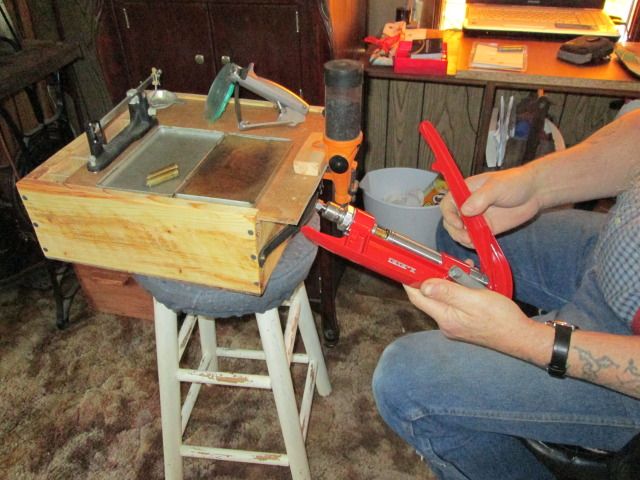
This one does, the new model has a bushing that releases with a button and a 1/4 turn. It comes with one as you see in the picture. Additional bushings can be ordered from Lee. Or you can just leave the bushing in place and screw your dies in like any other press.Now, if they ever make one that can use their interrupted thread quick change die adapter, that to me would be the ultimate setup for the Lee hand press.
OMG WANT!!!!!!!!!!!Pitchy wrote:This one does, the new model has a bushing that releases with a button and a 1/4 turn. It comes with one as you see in the picture. Additional bushings can be ordered from Lee. Or you can just leave the bushing in place and screw your dies in like any other press.Now, if they ever make one that can use their interrupted thread quick change die adapter, that to me would be the ultimate setup for the Lee hand press.